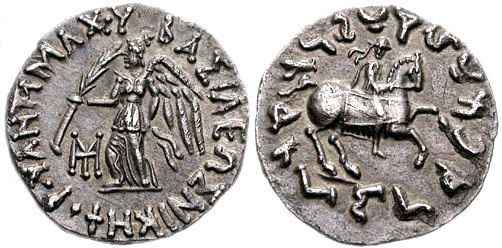Antimachus II on:
[Wikipedia]
[Google]
[Amazon]
Antimachus II Nikephoros ( Greek: ; the
 Antimachus II did not strike a portrait on his coins, likely since this was not custom in India. Neither did the early kings strike tetradrachms. Antimachus II struck a large number of bilingual drachms on the same lighter Indian standard as Apollodotus I, though round in shape. On the obverse is Nike, and on the reverse a king on horseback.
He also issued bilingual bronzes with aegis /
Antimachus II did not strike a portrait on his coins, likely since this was not custom in India. Neither did the early kings strike tetradrachms. Antimachus II struck a large number of bilingual drachms on the same lighter Indian standard as Apollodotus I, though round in shape. On the obverse is Nike, and on the reverse a king on horseback.
He also issued bilingual bronzes with aegis /
epithet
An epithet (, ), also a byname, is a descriptive term (word or phrase) commonly accompanying or occurring in place of the name of a real or fictitious person, place, or thing. It is usually literally descriptive, as in Alfred the Great, Suleima ...
means "the Victorious") was an Indo-Greek
The Indo-Greek Kingdom, also known as the Yavana Kingdom, was a Hellenistic period, Hellenistic-era Ancient Greece, Greek kingdom covering various parts of modern-day Afghanistan, Pakistan and northwestern India.
The term "Indo-Greek Kingdom" ...
king. He ruled a vast territory from the Hindu-Kush to the Punjab
Punjab (; ; also romanised as Panjāb or Panj-Āb) is a geopolitical, cultural, and historical region in South Asia. It is located in the northwestern part of the Indian subcontinent, comprising areas of modern-day eastern Pakistan and no ...
around 170 BCE. He was almost certainly the eponymous son of Antimachus I, who is known from a unique preserved tax receipt. Osmund Bopearachchi dated Antimachus II to 160–155 BCE on numismatical grounds, but changed this to 174–165 BCE after the tax receipt was revealed to synchronise his reign with that of Antimachus I.Boperarachchi (1991) and (1998), respectively. R. C. Senior has not dated Antimachus II but thinks that his coins were possibly Indian issues of Antimachus I, despite their different epithets and coin types.
In both of Boperachchi's reconstructions, Antimachus II was succeeded by Menander I who inherited three of his four monograms. Antimachus II probably fought against the Greco-Bactrian king Eucratides I, who had dethroned his father in Bactria.
Coins of Antimachus II
 Antimachus II did not strike a portrait on his coins, likely since this was not custom in India. Neither did the early kings strike tetradrachms. Antimachus II struck a large number of bilingual drachms on the same lighter Indian standard as Apollodotus I, though round in shape. On the obverse is Nike, and on the reverse a king on horseback.
He also issued bilingual bronzes with aegis /
Antimachus II did not strike a portrait on his coins, likely since this was not custom in India. Neither did the early kings strike tetradrachms. Antimachus II struck a large number of bilingual drachms on the same lighter Indian standard as Apollodotus I, though round in shape. On the obverse is Nike, and on the reverse a king on horseback.
He also issued bilingual bronzes with aegis / laurel wreath
A laurel wreath is a symbol of triumph, a wreath (attire), wreath made of connected branches and leaves of the bay laurel (), an aromatic broadleaf evergreen. It was also later made from spineless butcher's broom (''Ruscus hypoglossum'') or cher ...
and palm. Both these and the goddess Nike seem to allude to his epithet ''"the Victorious".''
See also
* Greco-Buddhism * Indo-ScythiansNotes
Sources
* * *"Sylloge Nummorum Graecorum 9", American Numismatic Society, New York, 1997. {{DEFAULTSORT:Antimachus 02 Greco-Bactrian kings 2nd-century BC monarchs in Asia Euthydemid dynasty